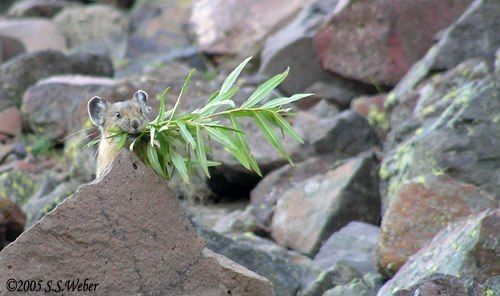Pika Research
Pikasare the only vocalizing members of the rabbit order. Gathered here are several of their calls, recorded by S. Weber starting in the 2006 field season.
The American pika (Ochotona princeps) lives primarily above tree line on high boulder-strewn slopes. About the size of a large hamster, pikas make hay piles during the summer which they defend vigorously, and eat from during the long winter under the snow. Pika populations appear to be increasingly adversely affected due to global warming pressures.
More information about ongoing pika research is available through the Bristlecone Institute and selected publications.
Pika Vocalizations
Short Calls
Saturday, June 30, 2007
Short calls are made by male and females, adults and juveniles. It may be something like an “I’m here” call. They often use this call just before leaving their territories to go collect plants for their hay piles, or when they are vocally “defending” their territories.
Alarm Calls
Saturday, June 30, 2007
Pikas will often warn their neighbors of danger with an alarm call like this one. Weasels, wolves, hawks and eagles will elicit this behavior. This is one of the benefits of living in a colony as pikas do, though they still maintain their own individual territories within it.
Pika or marmot?
Saturday, June 30, 2007
See if you can tell which call is which. Pikas and marmots are often found in overlapping territories, to the point where pikas sometimes collect haypiles directly on top of a marmot den. In this photo, a marmot (lower right) is resting on the doorstep of a pika and its hapile (upper left corner).
"Ratchet" Calls
Saturday, June 30, 2007
What I call ‘ratchet’ calls, for lack of a better description, often occur when a juvenile pika is being chased by an adult. This is common when juveniles are mature enough to leave the nursery area and start establishing their own discreet territories. Conflicts with established adults are frequent. Here short calls are mixed in with the ratchet call.
Use of this recording is not permitted without permission.
"Bray" or Long Call
Saturday, June 30, 2007
The ‘bray’ or long call appears to be an exclusively male call, with a nearby female often responding often simultaneously with her own short calls.
-
haying 1 opt2

-
Haypile 1 opt2

-
haypile1MT

-
pik13mt opt2

-
Pika1 opt2

-
pika1MT

-
Pika2 opt2

-
pika2MT

-
Pika3 opt2

-
Pika4 opt2

-
pika4MT

-
Pika5 opt2

-
pika5MT

-
pika6MT

-
Pika7 opt2

-
Pika8 opt2

-
Pika9 opt2

-
Pika10 opt2

-
pika10MT

-
pika11MT

-
Pika12 opt2

-
pika14MT

-
pika14mt opt2

-
pika16mt opt2

-
pika17mt opt2

-
pika18MT

-
pika19MT

-
pika20MT

-
pika21MT

-
pika21mt opt2

-
pika22MT

-
pika22mt opt2

-
pika23MT

-
pika24MT

-
pika24mt opt2

-
pika25MT

-
pika26MT

-
pika26mt opt2

-
pika27MT

-
pika28MT

-
pika29MT

-
pika30MT

-
pika30mt opt2

-
pika32MT

-
pika33MT

-
pika33mt opt2

-
pika34MT

-
pika34mt opt2

-
pika35MT

-
pika36MT

-
pika36mt opt2

-
pika37MT

-
pika37mt opt2

-
pika38MT

-
pika38mt opt2

-
pika39MT

-
pika40MT

-
pika41MT

-
pika42MT

-
pika43MT

-
pika44MT

-
pika45MT

-
pika47MT

-
pika50MT

-
pika51MT

-
pika52MT

-
pika53MT

-
pika54MT

-
pika55MT

-
pika56MT

-
pika57MT

-
pika59MT

-
pika60MT

-
pika61MT

-
pika62MT

-
pika63MT

-
pika65MT

-
pika66MT

-
pika68MT

-
pika69MT

-
pika70MT

-
Pikacall1 opt2

-
Pikahaying2 opt2

-
Pikahaypile2 opt2

-
Pikapee opt2

Copyright notice: All materials on this site are copyright protected. Unauthorized use is not permitted.










































































































































































